Abstract
In order to investigate myotatic reflex involvement in jaw muscle control, an analysis was made of the motor responses induced by mechanical vibration (120-160 Hz) of the jaw elevator muscles in healthy subjects. As seen in torque measurements and mean-voltage electromyographic (EMG) recordings, the vibration caused involuntary reciprocal changes in jaw muscle tone, the contraction force increasing in jaw elevators and decreasing in antagonistic jaw opening muscles. This tonic vibration reflex (TVR) elicited from the jaw elevators exhibited many characteristics similar to those previously described for limb muscle tonic vibration reflexes: it varied in strength from one subject to the next independently of the briskness of the jaw elevator tendon jerks; it had a gradual onset with successive recruitment of jaw elevator motor units firing largely out of phase with one another and at rates much lower than the vibration frequency; it was susceptible to voluntary control--when allowed visual feed-back from the torque meter all subjects were able to suppress the TVR and keep mean contraction force constant. The results indicate that with respect to the tonic motor response to sustained inflow in the Ia afferent nerve fibres, the jaw elevators do not differ markedly from other skeletal muscles. Independently of whether a TVR was present or not, the vibration caused a timing of the motor unit discharges in the jaw elevators that could not be controlled voluntarily and that showed up in gross EMG recordings as a marked grouping of discharges synchronous with each wave of vibration. A similar but less distinct grouping of the gross EMG pattern was seen in limb muscles exposed to vibration, the dispersion increasing with the peripheral conduction distances of the reflex arcs. It is suggested that contrary to the TVR, which depends on the sustained mean level of the Ia afferent input, the timing phenomenon depends, like the tendon jerk, on the degree of synchrony in the afferent Ia volleys. Monosynaptic projections may well be involved in the dynamic timing of motor discharges during tonic firing, but this does not imply that the TVR or the tonic stretch reflex is dependent upon such projections.
Full text
PDF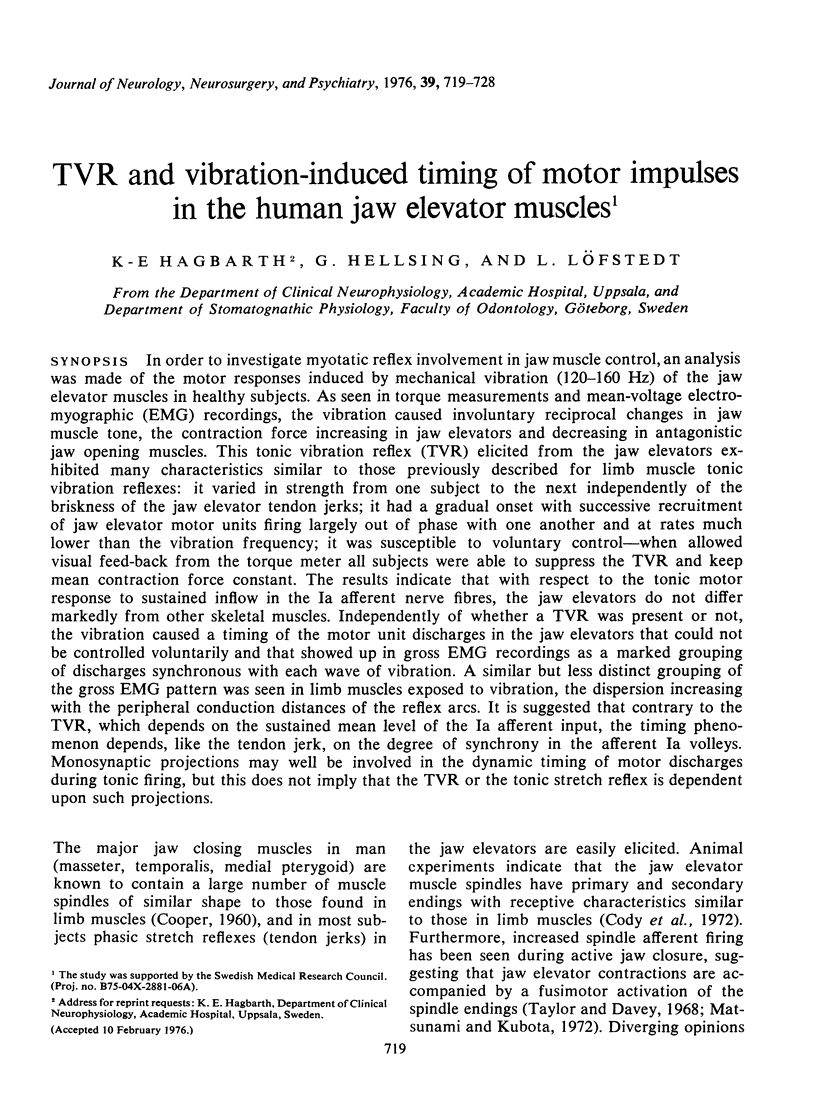
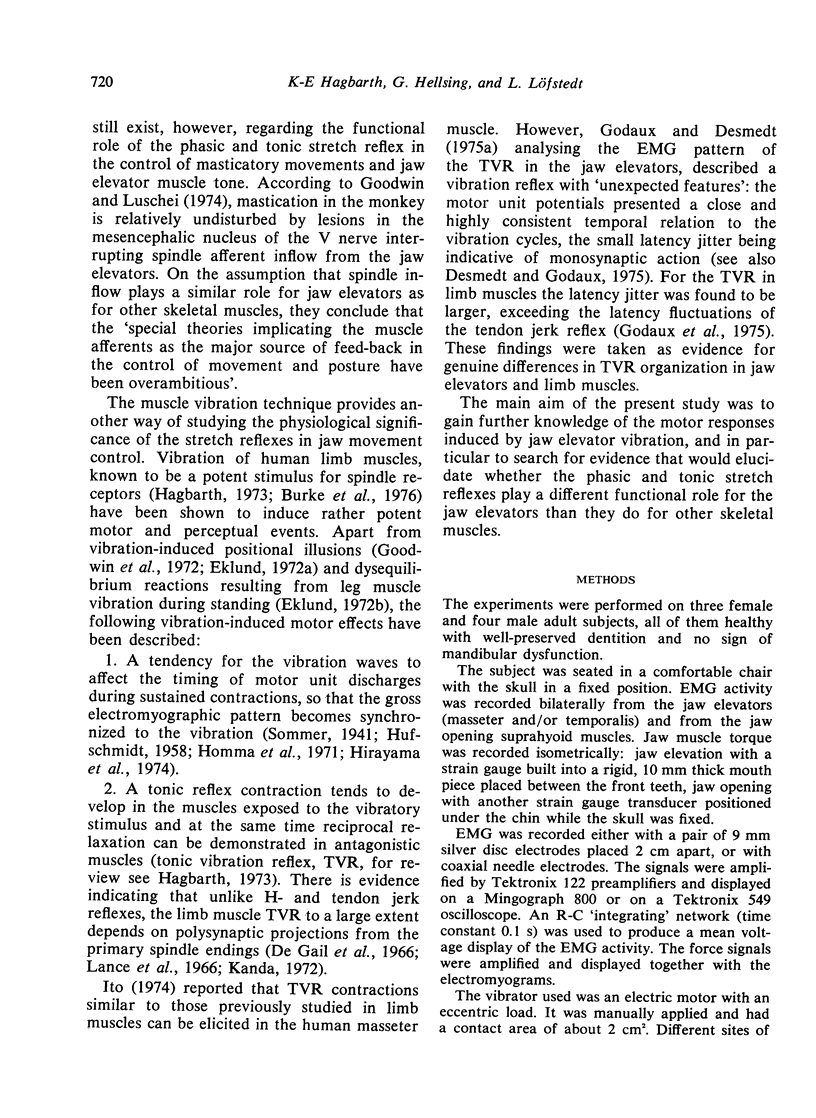
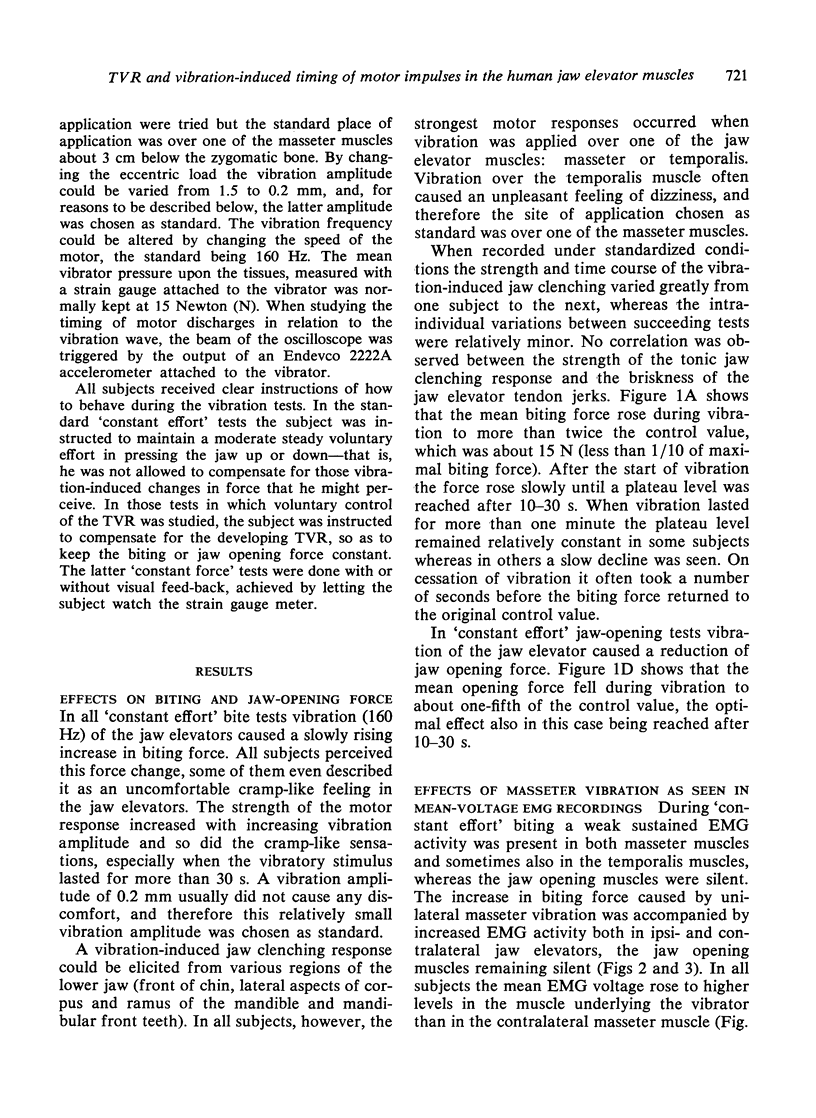
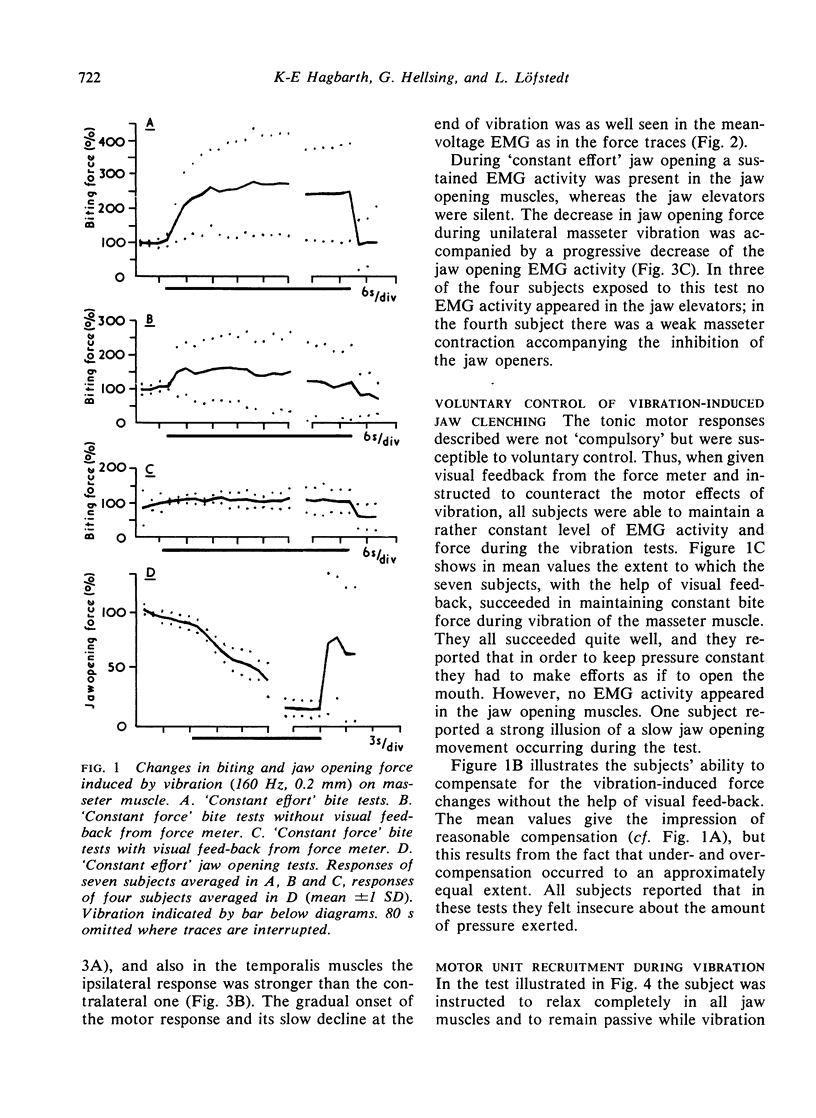
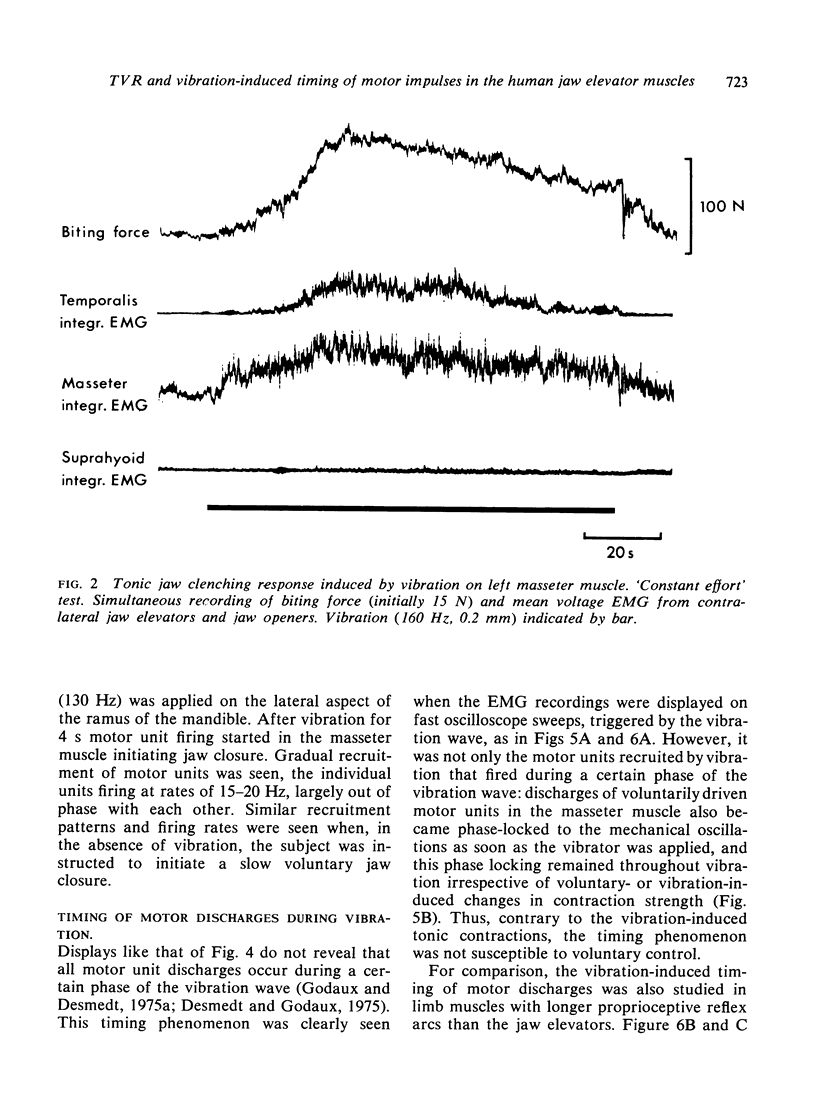
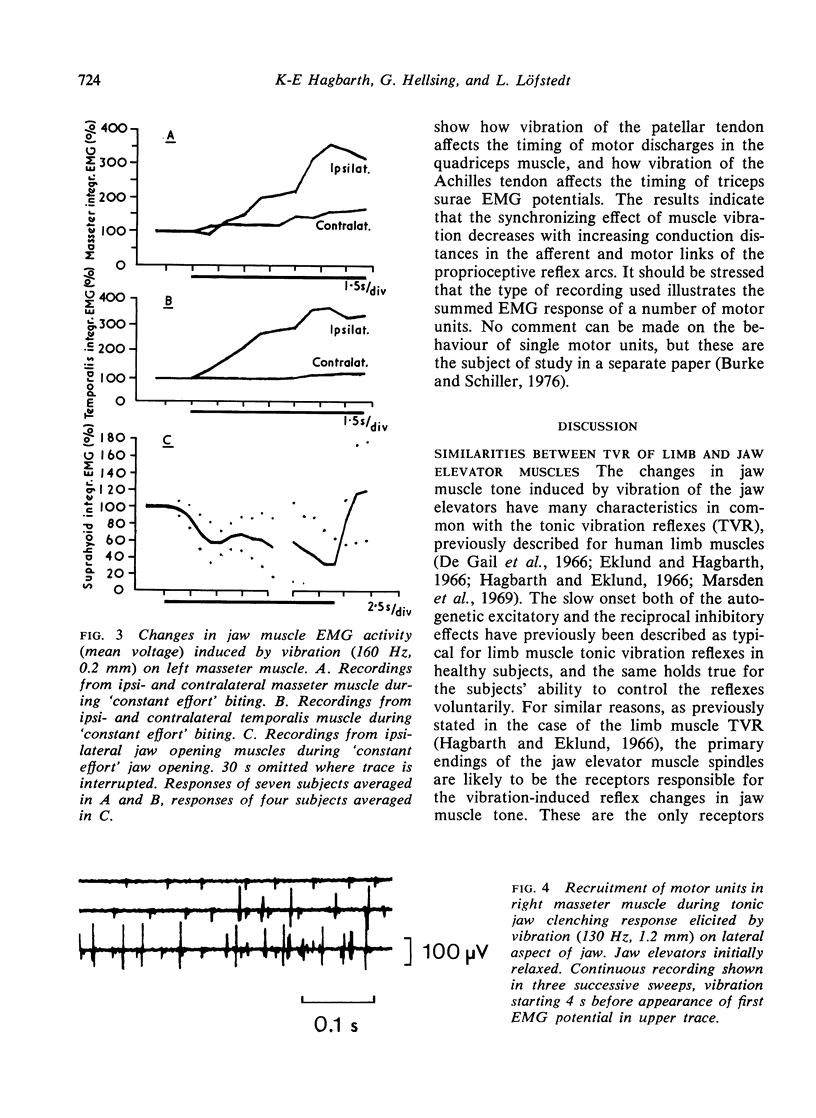
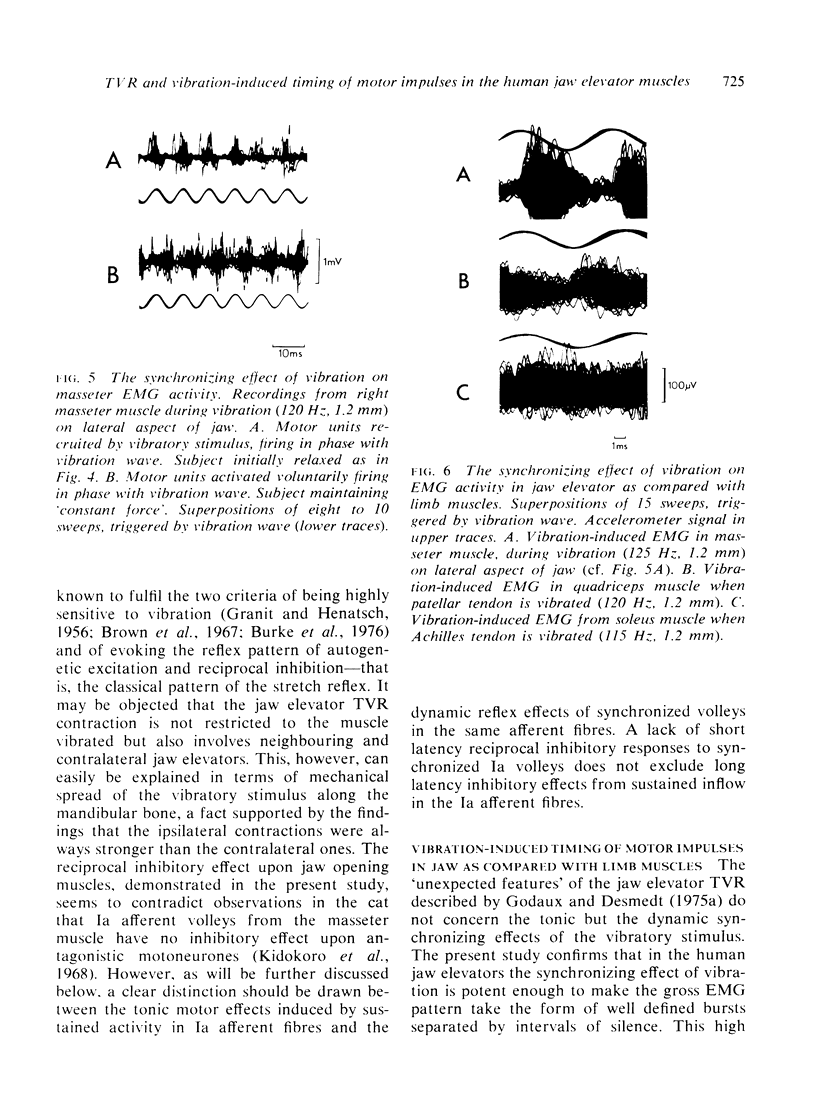
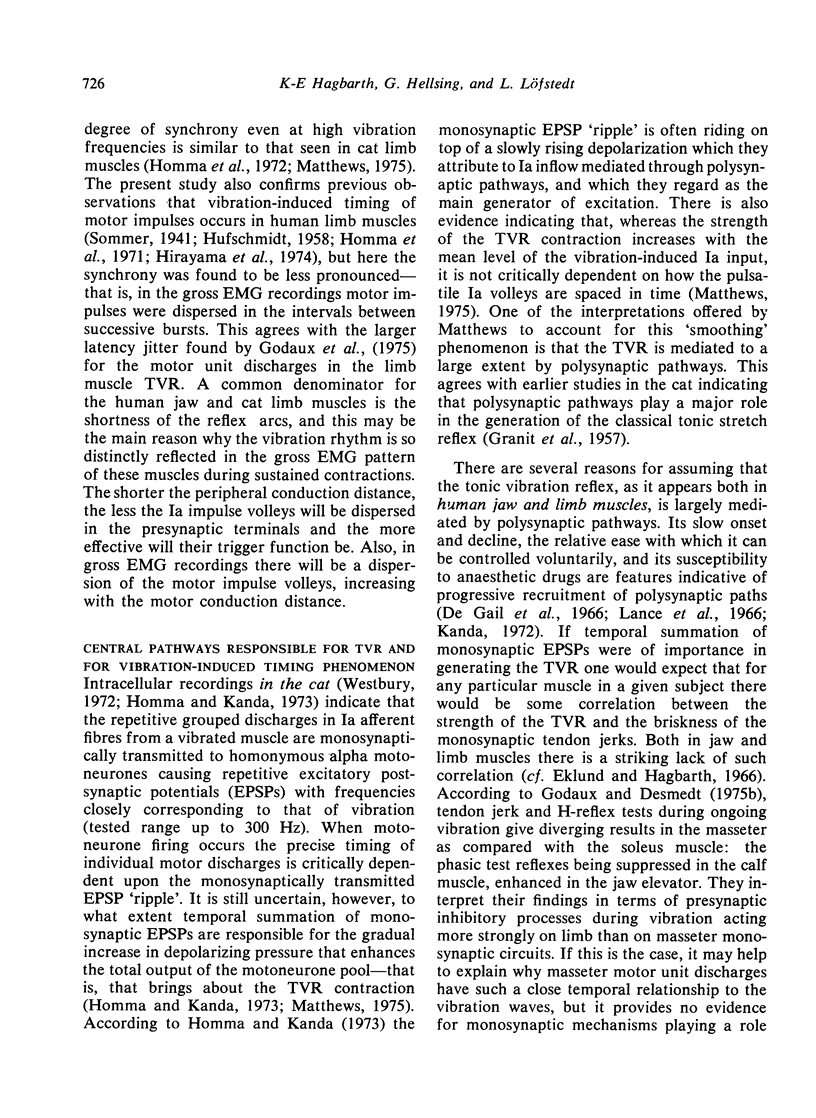
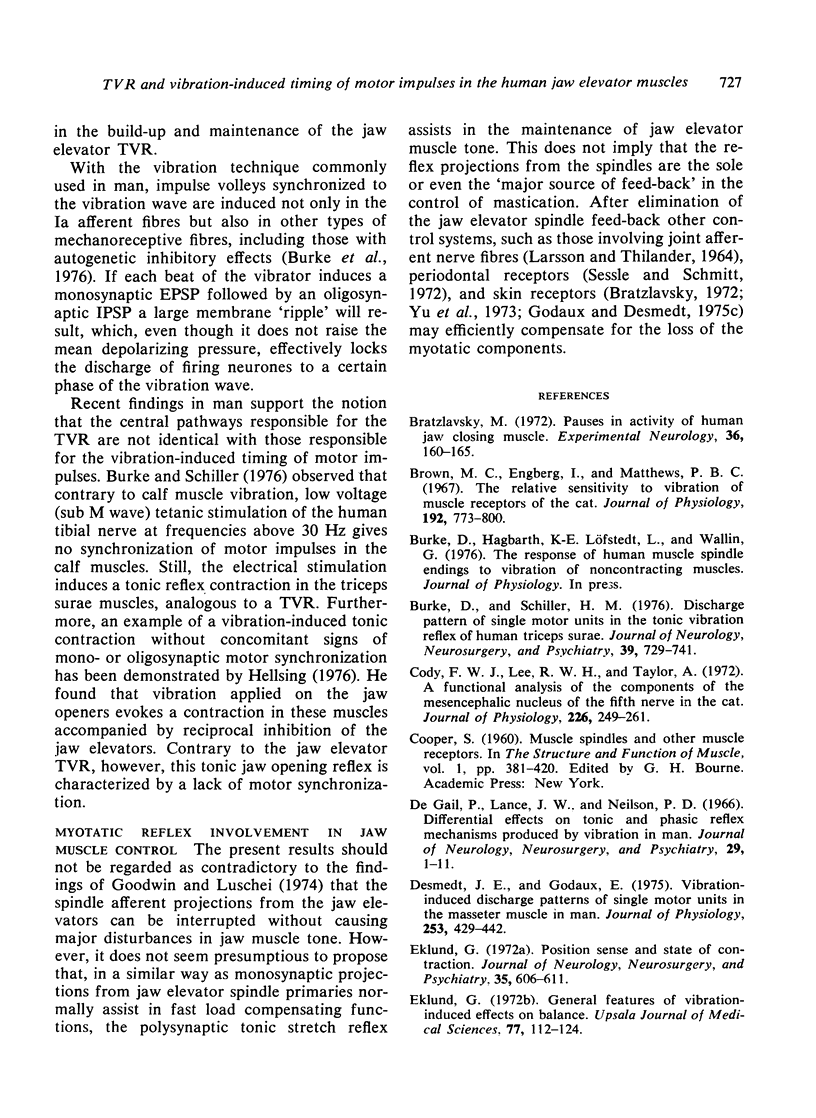
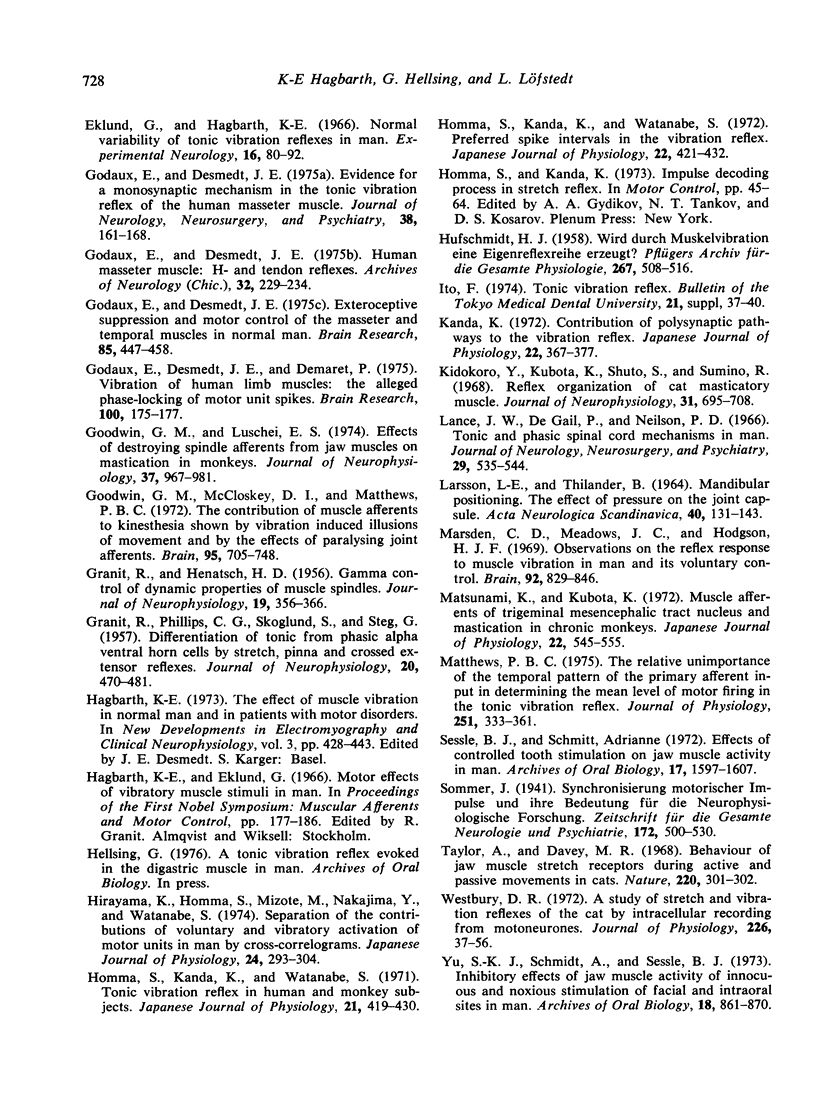
Selected References
These references are in PubMed. This may not be the complete list of references from this article.
- Bratzlavsky M. Pauses in activity of human jaw closing muscle. Exp Neurol. 1972 Jul;36(1):160–165. doi: 10.1016/0014-4886(72)90143-4. [DOI] [PubMed] [Google Scholar]
- Brown M. C., Engberg I., Matthews P. B. The relative sensitivity to vibration of muscle receptors of the cat. J Physiol. 1967 Oct;192(3):773–800. doi: 10.1113/jphysiol.1967.sp008330. [DOI] [PMC free article] [PubMed] [Google Scholar]
- Burke D., Schiller H. H. Discharge pattern of single motor units in the tonic vibration reflex of human triceps surae. J Neurol Neurosurg Psychiatry. 1976 Aug;39(8):729–741. doi: 10.1136/jnnp.39.8.729. [DOI] [PMC free article] [PubMed] [Google Scholar]
- Cody F. W., Lee R. W., Taylor A. A functional analysis of the components of the mesencephalic nucleus of the fifth nerve in the cat. J Physiol. 1972 Oct;226(1):249–261. doi: 10.1113/jphysiol.1972.sp009983. [DOI] [PMC free article] [PubMed] [Google Scholar]
- De Gail P., Lance J. W., Neilson P. D. Differential effects on tonic and phasic reflex mechanisms produced by vibration of muscles in man. J Neurol Neurosurg Psychiatry. 1966 Feb;29(1):1–11. doi: 10.1136/jnnp.29.1.1. [DOI] [PMC free article] [PubMed] [Google Scholar]
- Desmedt J. E., Godaux E. Vibration-induced discharge patterns of single motor units in the masseter muscle in man. J Physiol. 1975 Dec;253(2):429–442. doi: 10.1113/jphysiol.1975.sp011198. [DOI] [PMC free article] [PubMed] [Google Scholar]
- Eklund G. General features of vibration-induced effects on balance. Ups J Med Sci. 1972;77(2):112–124. doi: 10.1517/03009734000000016. [DOI] [PubMed] [Google Scholar]
- Eklund G., Hagbarth K. E. Normal variability of tonic vibration reflexes in man. Exp Neurol. 1966 Sep;16(1):80–92. doi: 10.1016/0014-4886(66)90088-4. [DOI] [PubMed] [Google Scholar]
- GRANIT R., HENATSCH H. D. Gamma control of dynamic properties of muscle spindles. J Neurophysiol. 1956 Jul;19(4):356–366. doi: 10.1152/jn.1956.19.4.356. [DOI] [PubMed] [Google Scholar]
- GRANIT R., PHILLIPS C. G., SKOGLUND S., STEG G. Differentiation of tonic from phasic alpha ventral horn cells by stretch, pinna and crossed extensor reflexes. J Neurophysiol. 1957 Sep;20(5):470–481. doi: 10.1152/jn.1957.20.5.470. [DOI] [PubMed] [Google Scholar]
- Godaux E., Desmedt J. E., Demaret P. Vibration of human limb muscles: the alleged phase-locking of motor unit spikes. Brain Res. 1975 Dec 12;100(1):175–177. doi: 10.1016/0006-8993(75)90255-3. [DOI] [PubMed] [Google Scholar]
- Godaux E., Desmedt J. E. Evidence for a monosynaptic mechanism in the tonic vibration reflex of the human masseter muscle. J Neurol Neurosurg Psychiatry. 1975 Feb;38(2):161–168. doi: 10.1136/jnnp.38.2.161. [DOI] [PMC free article] [PubMed] [Google Scholar]
- Godaux E., Desmedt J. E. Exteroceptive suppression and motor control of the masseter and temporalis muscles in normal man. Brain Res. 1975 Mar 7;85(3):447–458. doi: 10.1016/0006-8993(75)90819-7. [DOI] [PubMed] [Google Scholar]
- Godaux E., Desmedt J. E. Human masseter muscle: H- and tendon reflexes. Their paradoxical potentiation by muscle vibration. Arch Neurol. 1975 Apr;32(4):229–234. doi: 10.1001/archneur.1975.00490460045005. [DOI] [PubMed] [Google Scholar]
- Goodwin G. M., Luschei E. S. Effects of destroying spindle afferents from jaw muscles on mastication in monkeys. J Neurophysiol. 1974 Sep;37(5):967–981. doi: 10.1152/jn.1974.37.5.967. [DOI] [PubMed] [Google Scholar]
- Goodwin G. M., McCloskey D. I., Matthews P. B. The contribution of muscle afferents to kinaesthesia shown by vibration induced illusions of movement and by the effects of paralysing joint afferents. Brain. 1972;95(4):705–748. doi: 10.1093/brain/95.4.705. [DOI] [PubMed] [Google Scholar]
- HUFSCHMIDT H. J. Wird durch Muskelvibration eine Eigenreflexreihe erzeugt? Pflugers Arch. 1958;267(5):508–516. doi: 10.1007/BF00361737. [DOI] [PubMed] [Google Scholar]
- Hirayama K., Homma S., Mizote M., Nakajima Y., Watanabe S. Separation of the contributions of voluntary and vibratory activation of motor units in man by cross-correlograms. Jpn J Physiol. 1974 Jun;24(3):293–304. doi: 10.2170/jjphysiol.24.293. [DOI] [PubMed] [Google Scholar]
- Homma S., Kanda K., Watanabe S. Preferred spike intervals in the vibration reflex. Jpn J Physiol. 1972 Aug;22(4):421–432. doi: 10.2170/jjphysiol.22.421. [DOI] [PubMed] [Google Scholar]
- Homma S., Kanda K., Watanabe S. Tonic vibration reflex in human and monkey subjects. Jpn J Physiol. 1971 Aug;21(4):419–430. doi: 10.2170/jjphysiol.21.419. [DOI] [PubMed] [Google Scholar]
- Ito F. Tonic vibration reflex. Bull Tokyo Med Dent Univ. 1974 Aug;21 (Suppl)(0):37–40. [PubMed] [Google Scholar]
- Kanda K. Contribution of polysynaptic pathways to the tonic vibration reflex. Jpn J Physiol. 1972 Aug;22(4):367–377. doi: 10.2170/jjphysiol.22.367. [DOI] [PubMed] [Google Scholar]
- Kidokoro Y., Kubota K., Shuto S., Sumino R. Reflex organization of cat masticatory muscles. J Neurophysiol. 1968 Sep;31(5):695–708. doi: 10.1152/jn.1968.31.5.695. [DOI] [PubMed] [Google Scholar]
- LARSSON L. E., THILANDER B. MANDIBULAR POSITIONING. THE EFFECT OF PRESSURE ON THE JOINT CAPSULE. Acta Neurol Scand. 1964;40:131–143. doi: 10.1111/j.1600-0404.1964.tb01139.x. [DOI] [PubMed] [Google Scholar]
- Marsden C. D., Meadows J. C., Hodgson H. J. Observations on the reflex response to muscle vibration in man and its voluntary control. Brain. 1969;92(4):829–846. doi: 10.1093/brain/92.4.829. [DOI] [PubMed] [Google Scholar]
- Matsunami K., Kubota K. Muscle afferents of trigeminal mesencephalic tract nucleus and mastication in chronic monkeys. Jpn J Physiol. 1972 Oct;22(5):545–555. doi: 10.2170/jjphysiol.22.545. [DOI] [PubMed] [Google Scholar]
- Matthews P. B. The relative unimportance of the temporal pattern of the primary afferent input in determining the mean level of motor firing in the tonic vibration reflex. J Physiol. 1975 Oct;251(2):333–361. doi: 10.1113/jphysiol.1975.sp011096. [DOI] [PMC free article] [PubMed] [Google Scholar]
- Sessle B. J., Schmitt A. Effects of controlled tooth stimulation of jaw muscle activity in man. Arch Oral Biol. 1972 Nov;17(11):1597–1607. doi: 10.1016/0003-9969(72)90046-5. [DOI] [PubMed] [Google Scholar]
- Taylor A., Davey M. R. Behaviour of jaw muscle stretch receptors during active and passive movements in the cat. Nature. 1968 Oct 19;220(5164):301–302. doi: 10.1038/220301a0. [DOI] [PubMed] [Google Scholar]
- Westbury D. R. A study of stretch and vibration reflexes of the cat by intracellular recording from motoneurones. J Physiol. 1972 Oct;226(1):37–56. doi: 10.1113/jphysiol.1972.sp009972. [DOI] [PMC free article] [PubMed] [Google Scholar]
- Yu S. K., Schmitt A., Sessle B. J. Inhibitory effects on jaw muscle activity of innocuous and noxious stimulation of facial and intraoral sites in man. Arch Oral Biol. 1973 Jul;18(7):861–870. doi: 10.1016/0003-9969(73)90056-3. [DOI] [PubMed] [Google Scholar]


